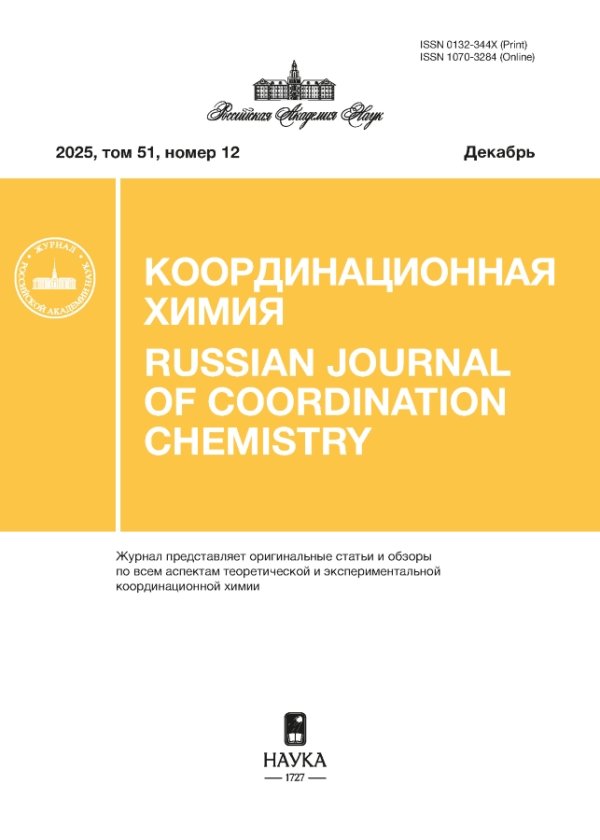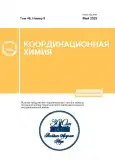Synthesis and Structure of Tetraphenylstibonium Organosulfonates Ph4SbOSO2R, R = C10H15O, C10H4(OH-1)(NO2)2-2,4, C10H7-1, C6H4(COOH-2)
- Authors: Senchurin V.S.1, Sharutin V.V.1, Sharutina O.K.1, Krasnoselskaya V.V.1
-
Affiliations:
- South Ural State University (National Research University), Chelyabinsk, Russia
- Issue: Vol 49, No 5 (2023)
- Pages: 315-320
- Section: Articles
- URL: https://journals.rcsi.science/0132-344X/article/view/137302
- DOI: https://doi.org/10.31857/S0132344X22600230
- EDN: https://elibrary.ru/FYPPSB
- ID: 137302
Cite item
Full Text
Abstract
The reaction of equimolar amounts of pentaphenylantimony with camphor-10-sulfonic, 2,4-dinitro-1-naphthol-7-sulfonic (flavianic), 1-naphthalenesulfonic, and 2-sulfobenzoic acids in benzene resulted in the synthesis of tetraphenylstibonium organosulfonates Ph4SbOSO2C10H15O∙H2O (I), Ph4SbOSO2C10H4(OH-1)(NO2)2-2,4∙PhH (II), Ph4SbOSO2(C10H7-1)∙H2O (III), and Ph4SbOSO2C6H4(COOH-2) (IV). According to X-ray diffraction data (CCDC no. 2119791 (I), 2121381 (II), 2116582 (III), and 2123516 (IV), the crystal of I contains trigonal-bipyramidal sulfonate molecules (the axial Sb−C and Sb−O bond lengths are 2.130(3) and 2.565(2) Å, respectively) and hydration water molecules, which form a centrosymmetric eight-membered ring (the S=O∙∙∙H−O−H∙∙∙O=S distances are 2.06 and 2.21 Å). In the molecules of II, the metal atom geometry is a distorted trigonal bipyramid (the axial Sb−C and Sb−O bonds are 2.133(2) and 2.643(3) Å, respectively). The Sb−O distance (2.842(3) Å) is longer in III than in I or II; the hydration water molecules form centrosymmetric twelve-membered rings with the anions (the S=O∙∙∙H−O−H∙∙∙O=S distances are 2.02 and 2.05 Å). Meanwhile, the crystal of compound IV consists of tetrahedral tetraphenylstibonium cations and (2-carboxy)benzenesulfonate anions with the intramolecular O−H∙∙∙O=S hydrogen bond (1.75 Å).
About the authors
V. S. Senchurin
South Ural State University (National Research University), Chelyabinsk, Russia
Email: senvl@rambler.ru
Россия, Челябинск
V. V. Sharutin
South Ural State University (National Research University), Chelyabinsk, Russia
Email: senvl@rambler.ru
Россия, Челябинск
O. K. Sharutina
South Ural State University (National Research University), Chelyabinsk, Russia
Email: senvl@rambler.ru
Россия, Челябинск
V. V. Krasnoselskaya
South Ural State University (National Research University), Chelyabinsk, Russia
Author for correspondence.
Email: senvl@rambler.ru
Россия, Челябинск
References
- Шарутин В.В., Поддельский А.И., Шарутина О.К. // Коорд. химия. 2020. Т. 46. № 10. С. 579 (Sharutin V.V., Poddel’sky A.I., Sharutina O.K. // Russ. J. Coord. Chem. 2020. V. 46. № 10. P. 663). https://doi.org/10.1134/S1070328420100012
- Mishra J., Saxena A. Singh S. // Curr. Med. Chem. 2007. V. 14. P. 1153. https://doi.org/10.2174/092986707780362862
- Mushtaq R., Rauf M.K., Bond M. et al. // Appl. Organomet. Chem. 2016. V. 30. P. 465. https://doi.org/10.1002/aoc.3456
- Saleem L., Altaf A.A., Badshah A. et al. // Inorg.Chim. Acta. 2018. V. 474. P. 148. https://doi.org/10.1016/j.ica.2018.01.036
- Oliveira L.G., Silva M.M., Paula F.C.S. et al. //Molecules. 2011. V. 16. P. 10314. https://doi.org/10.3390/molecules161210314
- Islam A., Da Silva J.G., Berbet F.M. et al. // Molecules. 2014. V. 19. P. 6009. https://doi.org/10.3390/molecules19056009
- Mushtaq R., Rauf M.K., Bolte M. et al. // Appl. Organomet. Chem. 2017. V. 31. e3606. https://doi.org/10.1002/aoc.3606
- Yu L., Ma Y.-Q., Liu R.-C. et al. // Polyhedron. 2004. V. 23. P. 823. https://doi.org/10.1016/j.poly.2003.12.002
- Wang F., Yin H., Yue C. et al. // J. Organomet. Chem. 2013. V. 738. P. 35. https://doi.org/10.1016/j.jorganchem.2013.03.046
- Islam A., Rodrigues B.L., Marzano I.M. et al. // Eur. J. Med. Chem. 2016. V. 109. P. 254. https://doi.org/10.1016/j.ejmech.2016.01.003
- Iftikhar T., Rauf M.K., Sarwar S. et al. // J. Organomet. Chem. 2017. V. 851. P. 89. https://doi.org/10.1016/j.jorganchem.2017.09.002
- Jiang J., Yin H., Wang D. et al. // Dalton Trans. 2013. V. 42. P. 8563. https://doi.org/10.1039/c3dt50221j
- Yu L., Ma Y.-Q., Wang G.-C., Li J.-S. // Heteroat. Chem. 2004. V. 15. P. 32. https://doi.org/10.1002/hc.10208
- Polychronis N.M., Banti C.N., Raptopoulou C.P. et al. // Inorg. Chim. Acta. 2019. V. 489. P. 39. https://doi.org/10.1016/j.ica.2019.02.004
- Шарутин В.В., Шарутина О.К., Пакусина А.П. и др. // Коорд. химия. 2004. Т. 30. № 1. С. 15 (Sharutin V.V., Sharutina O.K., Pakusina A.P. et al. // Russ. J. Coord. Chem. 2004. V. 30. № 1. P. 13). https://doi.org/10.1023/B:RUCO.0000011636.28262.d3
- Кочешков К.А., Сколдинов А.П., Землянский Н.Н. Методы элементоорганический химии. Сурьма, висмут. М.: Наука, 1976. 485 с.
- SMART and SAINT-Plus. Version 5.0. Data Collection and Processing Software for the SMART System. Madison (WI, USA): Bruker AXS Inc., 1998.
- SHELXTL/PC. Version 5.10. An Integrated System for Solving, Refining and Displaying Crystal Structures from Diffraction Data. Madison (WI, USA): Bruker AXS Inc., 1998.
- Dolomanov O.V., Bourhis L.J., Gildea R.J. et al. // J. A-ppl. Cryst. 2009. V. 42. P. 339. https://doi.org/10.1107/S0021889808042726
- Cordero B., Gómez V., Platero-Prats A.E. et al. // Dalton Trans. 2008. V. 21. P. 2832. https://doi.org/10.1039/B801115J
- Mantina M., Chamberlin A.C., Valero R. et al. // J. Phys. Chem. A. 2009. V. 113. № 19. P. 5806. https://doi.org/10.1021/jp8111556
- Ferrer E.G., Williams P.A.M., Castellano E.E., Piro O.E. // Z. Anorg. Allg. Chem. 2002. V. 628. P. 1979. https://doi.org/10.1002/1521-3749(200209)628:9/10< 1979::AID-ZAAC1979>3.0.CO;2-V
- Преч Э., Бюльманн Ф., Аффольтер К. Определение строения органических соединений. М.: Мир; БИНОМ. Лаборатория знаний, 2006. 438 с.
Supplementary files
















